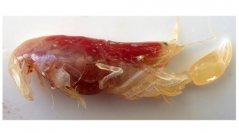

 European Journal of Taxonomy
774 (42) - Pages 42-57
European Journal of Taxonomy
774 (42) - Pages 42-57A new alpheid shrimp, Aretopsis sandybrucei sp. nov., is described on the basis of three specimens collected from three deep-water banks in the Chesterfield Plateau of the Coral Sea, between New Caledonia and Queensland, Australia, at a depth range of 280–550 m. The new species is the first known deep-water species of the genus Aretopsis De Man, 1910, with its two congeners, A. amabilis De Man, 1910 and A. manazuruensis Suzuki, 1971, being confined to the lower intertidal and shallow subtidal areas, to a maximum depth of 50 m. Based on morphological grounds, A. sandybrucei sp. nov. can be easily separated from A. amabilis and A. manazuruensis by the generally much stouter third to fifth pereiopods, with their dactyli each bearing a very small secondary unguis on the flexor margin, in comparison to a much stronger one in the other two species. Aretopsis sandybrucei sp. nov. also differs from A. amabilis and A. manazuruensis by the less contrasting colour pattern, including the more translucent, dull yellowish chelae and tail fan. An association of A. sandybrucei sp. nov. with a deep-water hermit crab appears to be highly likely due to the presence of several large hermit crabs (Paguridae) in at least one of the three dredge/bottom trawl hauls, which was also containing a paratype of the new species. The taxonomic status of A. amabilis and A. manazuruensis is discussed.
Marine biodiversity, crustacean, West Pacific, Chesterfield Plateau, symbiosis